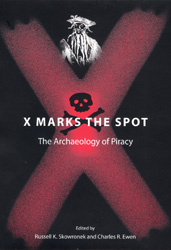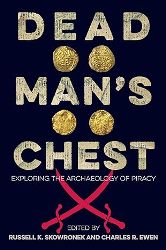 Pirates and Privateers Pirates and Privateers
The History of Maritime
Piracy
Cindy Vallar, Editor
& Reviewer
P.O. Box 425,
Keller, TX 76244-0425
    
Books for Adults ~ Archaeology
X
Marks the Spot
Dead Man's
Chest

X Marks the Spot
The Archaeology of Piracy
Edited by Russell K. Skowronek and Charles R. Ewen
University Press of Florida, 2006, ISBN 0-8130-2875-2,
US $55
    
Much of what is known of pirates of yore comes from
historical records, but is there archaeological
evidence to support or enhance that information?
Editors Russell K. Skowronek, associate professor of
anthropology and founder of the Archaeology Research
Lab at Santa Clara University, and Charles R. Ewen,
professor of anthropology and director of the
Archaeology Laboratories at East Carolina
University, decided to see what insights archaeology
has offered about “the world of the pirates.” X
Marks the Spot is divided into three parts:
Pirate Lairs, Pirate Ships and Their Prey, and
Pirates in Fact and Fiction. The various essays
within each section are written by archaeologists or
those who have worked closely with them to unearth
new data and artifacts. "Pirate Lairs" explores the
pirate haven Port Royal, Jean Laffite’s Barataria,
and the Bay of Honduras. "Pirate Ships and Their
Prey" examines the Speaker (the first
pirate ship ever excavated archaeologically), the Fiery
Dragon (Christopher Condent’s ship), the Whydah
(Samuel Bellamy’s ship), and the Queen
Anne’s Revenge (Blackbeard’s flagship), as
well Mississippi River pirates and identifying
pirate victims in the Spanish Caribbean. The final
section examines pirate imagery and whether or not
"X" marks the spot.
Perhaps, the two opening quotes of the Introduction
best sum up the editors’ goals in compiling these
essays:
Archaeology
is the search for fact. Not truth. If it’s truth
you’re interested in, Dr. Tyree’s philosophy
class is right down the hall. So forget any
ideas you’ve got about lost cities, exotic
travel, and digging up the world. We do not
follow maps to buried treasure and “X” never,
ever, marks the spot! – Indiana Jones
Sometimes it does.
– The authors of this book
X Marks the Spot
includes a brief look into the history of piracy,
with particular focus on the Caribbean, North
America, and the Indian Ocean. What the editors
discovered as they researched was that there are
myriad historical works about pirates, but very
little archaeological literature on them. Each essay
includes maps, charts, illustrations, and pictures
of artifacts. There is also an extensive
bibliography and index.
This proved to be a most interesting book, and for
the most part the essays make fascinating reading.
It’s a look at piracy from a perspective rarely
seen, and the conclusions the archaeologists have
drawn are intriguing. While the price is a bit dear,
X Marks the Spot is a worthy addition to any
serious pirate’s collection.
Review Copyright ©2006 Cindy Vallar


Dead Man’s Chest
Exploring the Archaeology of Piracy
edited by Russell K. Skowronek and Charles R.
Ewen
University Press of Florida, 2023, ISBN
978-0-8130-6974-6, US $45.00
    
Archaeology
studies what remains of
people who lived in the
past. History tells us
what happened and why. One
examines the physical
items left behind, whereas
the other peruses the
written records. Over the
years many histories of
pirates have been written,
but no one had seriously
considered studying the
archaeology of piracy.
Skowronek and Ewen wanted
to change that; in 2006,
they found other
like-minded people and
published X Marks the
Spot. Ten years
later, they brought us Pieces
of Eight. In both
titles, their intent was
not to craft stuffy,
pedantic volumes that were
meant only for students
and practitioners of
archaeology. They wished
to also share the
knowledge found with
others interested in
maritime piracy. Now, they
add a third volume to the
mix. Dead Man’s Chest
shines a light on new
avenues of study and
revisits a few finds to
provide different
perspectives. The sixteen
essays found here are
written by doctoral
candidates,
archaeologists, curators,
consultants, historians,
paleographers, professors,
anthropologists,
conservationists,
archivists, and
oceanographers.
Although
popular culture tends to
celebrate pirates, the
men and women who preyed
upon merchantmen during
the Golden Age of Piracy
were actually thieves
and murderers who
utilized violence and
intimidation to acquire
their ill-gotten goods.
Ewen’s opening salvo
shines a
thought-provoking light
on this reality in “On
Celebrating Piracy: But
Should We?”
From here,
the book is divided into
four sections: Pirate
Swag: Material Culture
Studies, Transatlantic
Piracy, Pirates of the
Caribbean and Tierra
Firma, and Piracy in the
Indian Ocean. The first
set of essays discusses
some of the artifacts
that archaeologists have
unearthed and what those
tell us about pirates.
Kimberley P. Kenyon’s
“The Stories They Tell:
Recent Finds from Queen
Anne’s Revenge/La
Concorde”
highlights recovered
items from Blackbeard’s
flagship. Since this
vessel was a slaver
before pirates acquired
it, she highlights the
dilemma of determining
whether an artifact
belonged to or was used
by pirates (a theme that
surfaces in several
other essays in the
book). Jessie Cragg and
Michael Thomin remind us
that pirates also lived
ashore in “Sail Bags and
Black Flags: Identifying
Material Culture of
Nineteenth-Century
Pirates.” It concerns a
ship that set sail in
1794. Instead of the few
weeks it should have
taken to arrive at her
destination, the voyage
lasted five months
because pirates attacked
twice. In “‘Running a
Rig’: Pirates and
Archaeology in Video
Games,” Coy J. Idol and
Katherine D. Thomas
discuss the influences
of archaeology on Assassin’s
Creed IV: Black Flag
and Uncharted 4: A
Thief’s End. Jean
Soulat’s focus in “The
Material Culture of
Pirate Wrecks and Lairs:
A Reflection of Colonial
Archaeology through
Multicultural
Assemblages from the
Seventeenth and
Eighteenth Centuries”
explores the delineation
of items found at
archaeological digs and
how it may be possible
to differentiate between
those that belonged to
pirates and those that
did not.
The second
group of essays
continues this
comparison between legal
and illegal behavior as
it relates to piracy. In
“Casting Piracy a Line:
An Examination of the
Influence of Piracy in
the Archaeological
Record of Two New
England Fishing
Settlements,” Megan
Rhodes Victor shows how
difficult it can be to
distinguish between
fishermen and pirates
when they inhabit the
same area. Patrick J.
Boyle’s “The Archaeology
of Lundy Pirates: A Case
Study of Material
Culture” concerns a
known area frequented by
pirates and whether
found items are
connected to pirates.
Bradley Rodgers and
Jason T. Raupp’s “The
Mystery of Morgan’s
Island: Archaeological
Insights into a Possible
Pirate Wreck at
Somerset, Bermuda”
demonstrates how the
confluence of historical
documentation and
archaeological studies
allow for a
reexamination of a past
event and its proper
interpretation.
The third
set of essays opens with
Kenneth S. Wild’s
“What’s to Become of Me?
Pirates and Refugees in
the Archaeological
Landscape of the Virgin
Islands.” Here, he
focuses on pirateering,
a profession where the
line between
privateering and piracy
blurred. Alexandre
Coulaud, Nathalie
Sellier-Ségard, and
Martijn van den Bel
demonstrate the
possibility of an
emerging pattern in
locations where pirates
are thought to have set
up temporary camps in
“Pirates at Grand Case
Bay, St. Martin (French
West Indies):
Interpreting
Archaeological Evidence
from a
Late-Seventeenth-Century
Settlement.” Tortuga has
long been associated
with pirates, but
archaeological studies
of the island have not
been possible; Laurent
Pavlidis suggests
avenues of research
should that change in
“Mysterious Tortuga
Island, Republic of
Haiti.” Geraldo J. S.
Hostin’s investigation
into “The Pirate of
Cotinga Island: The
History and Archaeology
of a Mysterious
Shipwreck in the South
of Brazil” puts forth a
convincing case as to
the identity of the
pirate who lost his ship
in 1718. Lynn B. Harris
concentrates on the
connections between
“Buccaneers and
Harpooners of the
Miskito Coast.”
Archaeological
investigations in the
Indian Ocean are the
topic of the fourth
section of essays. John
de Bry and Jean Soulat
discuss recent and
upcoming explorations of
“Pirate Lairs in
Ambodifototra Bay
(Saint-Marie Island,
Madagascar)? Traces of
Fortifications and Camps
in Archives and
Archaeological Remains.”
A French expedition
discovered one of the
earliest pirate
shipwrecks in 1979.
Soulat, Yann von Arnim,
and Patrick Lizé
reconsider what
archaeologists
discovered and how they
made their determination
in “The Speaker (1702)
Pirate Shipwreck on the
East Side of Mauritius:
Review of Archaeological
Data and Research
Perspectives.”
The parting
shot in this collection
comes from Skowronek
with “Unpacking the Dead
Man’s Chest.” When X
Marks the Spot
came out, the majority
of the research shared
came from historical
inquiries. Whereas
archaeological waters
were uncharted then,
much like in the days of
these pirates, Dead
Man’s Chest and
its companion volumes
show that the
archaeology of piracy
does exist and can shed
new light on pirates and
how they lived.
We tend to
think of archaeology as
stodgy and dull.
Sometimes, it takes just
one book to show us the
error of that thinking.
(My awakening came when
I read Anna Ritchie’s Viking
Scotland.) To find
not one but three
offerings that achieve
this for pirate
afficionados is a true
treasure trove. Dead
Man’s Chest is
enlightening,
entertaining, and
compelling. The
pictures, tables, and
maps provide us with
concrete examples, while
the references and index
permit us to explore the
archaeology of piracy
further. Skowronek and
Ewen, as well as the
contributors, share
their enthusiasm and
knowledge to mentor and
inspire us, whether we
are armchair wannabes,
exploring a possible
career, or already
working in the field of
archaeology. If you want
to know about piracy
during the early
eighteenth century, Dead
Man’s Chest is a
must read. Once read,
you’ll want to delve
into the earlier volumes
to learn even more.
Review
Copyright ©2023
Cindy Vallar


Click to contact me
Background image compliments
of Anke's Graphics |


